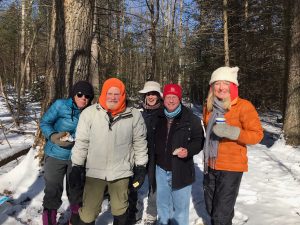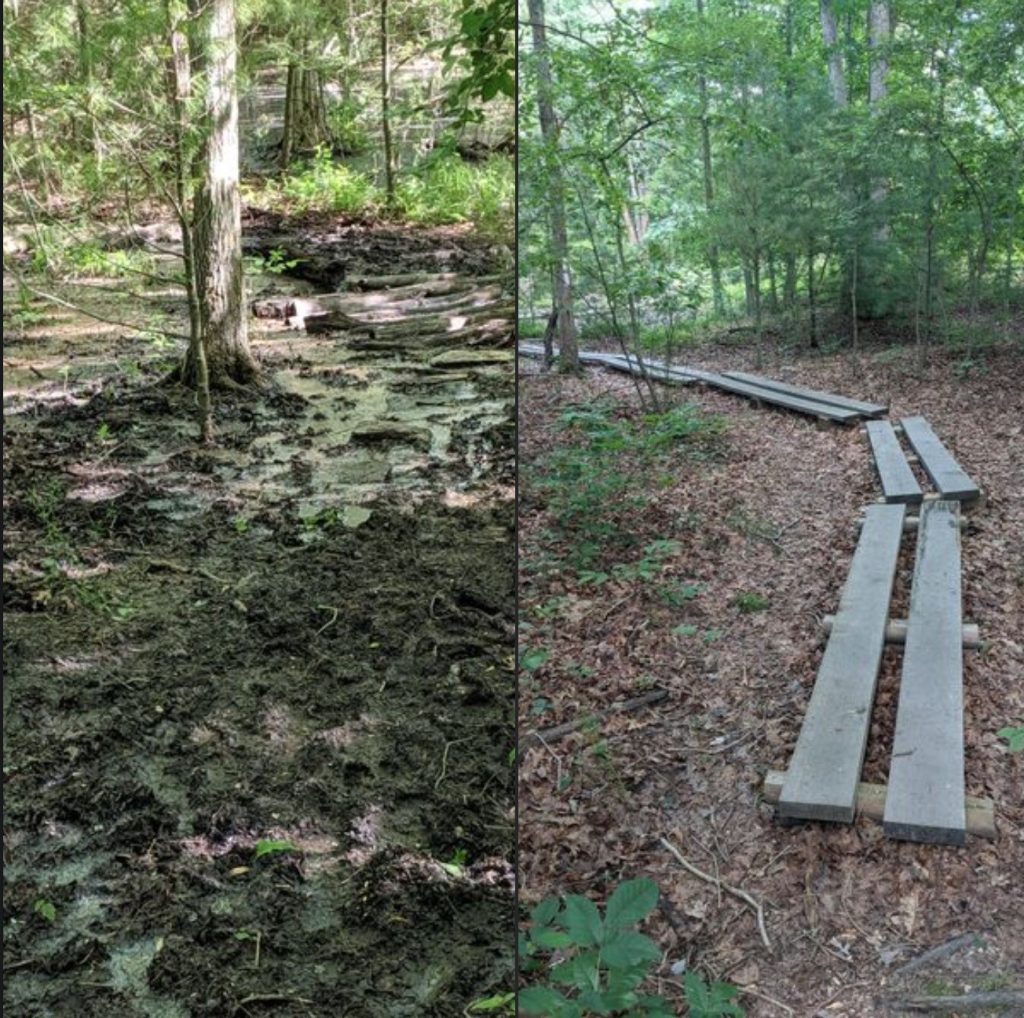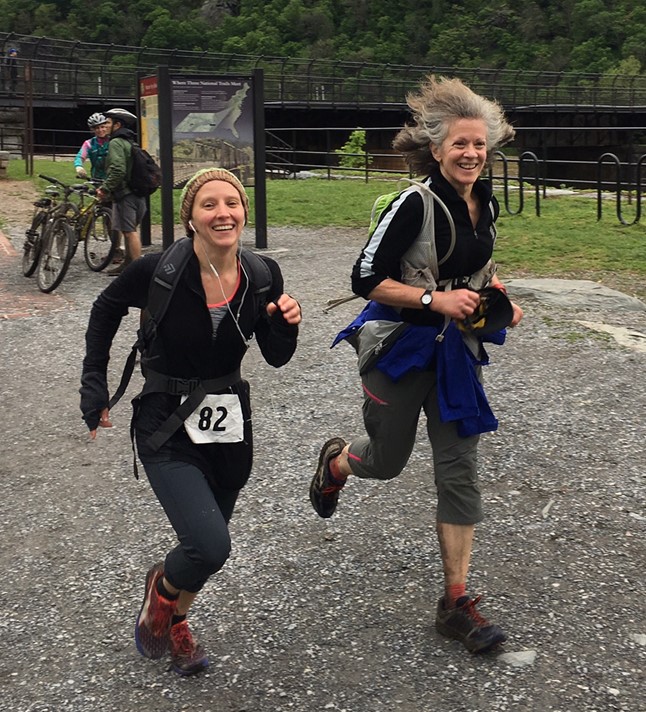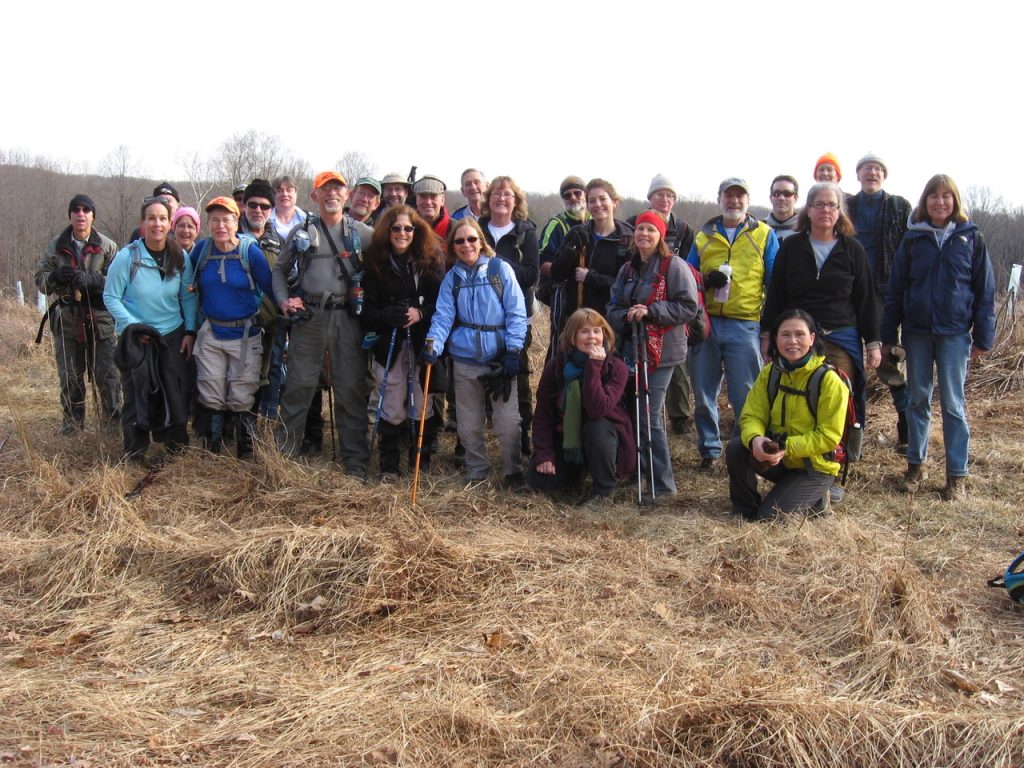
MCM First Person: Stories And Memories About The Mountain Club Of Maryland
As part of our celebration of MCM’s 90th Anniversary, members are invited to submit reminisces and anecdotes about hiking with our club. Your submissions will be shared with other members on this web page, and preserved in a single document to be available to future club members. Please send your memories to trailsaunders@gmail.com.
JERRY WRIGHT
I joined MCM shortly after moving to the Baltimore area in 1999, specifically because it was doing trail maintenance on the Appalachian Trail. I had started taking 2-week long volunteer vacations working on trails in wilderness areas with the US Forest Service about 12 years earlier and this was a opportunity to do some work locally. I could leave for a day, drive to a work location, and be home in the evening. The majority of trail maintenance is rearranging local materials so the final product does not look like it has been constructed; the trail just belongs at that location.
In the early 2000s, the major relocation projects were finished and work became more focused on rehabilitating worn and eroded sections. The large rehab projects, such as Hawk Rock stairs rebuild, were beyond the available volunteer resources to do in a timely manner; the ATC mid-Atlantic crew was brought in for weeks to handle that project.
About 11 years ago I was offered the position of trail supervisor and decided to accept as I was then newly retired and would have time to adequately organize crews. There’s a lot more going on behind the scenes to get a crew in the field than most people realize. The days of large crews working on long sections of trail for a day had become the thing of the past. Much routine maintenance could be done by small crews of 1 or 2 people helping a specific section maintainer. It became apparent to keep MCM trail crews active, we had to switch to more technical skilled projects such as movement and rearrangement of multi-ton boulders to clear up problems spots.
One very wet year exposed a lot of poor drainage places that became permanent mud holes. We put down puncheon at these locations which involved organizing the purchase of 7 tons of materials from 3 vendors to be delivered at 5 project locations in 2 states. Getting hikers out of the muck in wet weather allowed the ground to heal and produce vegetation. Now when you hike the trail in dry weather, you wonder why the puncheon is there. Without it, you’d be calf deep in mud.
The most recent major project brought together all the skills the crew had be learning over the previous year plus added a few more to the mix. This was the relocation and replacement of the footbridge at Tagg Run in Micheaux SF in PA. The new bridge is 38 feet long, constructed from white oak timber felled and milled on location. This involved a lot of rock drilling, breaking and shaping to make the abutment foundations, grip-hoist work to move the stones into place, chainsaw milling to make deck and railing boards and relocating the trail to meet the new location.
Attached photos are before and 2 years after puncheon same location 300 feet north of Hunters Run trailhead parking in Pennsylvania.

BRIDGET MCCUSKER
MCM Reflections – 2024
In October of 1993, I made a decision to finally sign up for a MCM hike. I had been on the AT once about 10 years earlier and wanted to return so the MCM seemed like a good place to start. I picked a hike on the AT being led by Walter Pocock. It was a 12 mile hike from Harpers Ferry to the Blackburn Trail Center. Walter grilled me and was concerned that I did not have much experience on hiking trails. I told him that I walked a lot and had been taking step aerobics classes which didn’t seem to impress him, but in the end, he allowed me to sign up. When I showed up at the meeting place and saw Walter, I was surprised to see a slender man with a white beard wearing an old wool sweater. It was a large and friendly group with people of all ages and some who like me were first timers and others who were seasoned MCM hikers. We arrived at the parking lot close to the Route 340 bridge over the Potomac and then had to wait for the car plant which completely baffled me. In the past, I have led car plant hikes and these days I avoid them.
I enjoyed that first MCM hike and met some really nice people. As Walter led the hike, once in a while he would stroll by going toward the back to check on the new people which reminds me of hiking with Jim Koury who always makes a point to check in with new hikers or catch up with people he hasn’t seen in a while. From that first hike on, I was inclined to sign up for Walter’s hikes because they challenged me and exposed me to hikes in places that were new to me. I got to know a group of hikers who liked the long and strenuous hikes and we often stopped for dinner on the way home which meant it was often dark by the time we got home. Some of the people who regularly hiked with Walter included Steve Burkett, he worked on the club’s early website, Rick Royer, Ron Steinberg, Jesse Dobbs, Gwen?, Karin Palm, Eva Barnhill, David Axon, and others whose names I can’t remember 30 years later. I submitted my membership application shortly after my first hike in October 1993 but was not officially a member until sometime in early 1994. Little did I know that your application had to be reviewed and approved by the trail council.
In 1995 I signed up for my first HAM and as of 2019 I have completed it 10 times. I started this year and was doing okay but decided to drop out at the
Weverton parking lot due to some aches and pains that were getting the best of me. I was also soaked through and through as it started to pour just as I started down the climb from Weverton Cliffs. The temperature was actually refreshing and I safely made it to the bottom. Some people can’t believe that I dropped out with just 3 more easy miles to go on the towpath but it was not a hard decision for me. I think I’ll opt to volunteer for future HAMs.
I was encouraged to lead hikes by Walter and by the late 90s I was hiking regularly with Karen Klinedinst, Ron Eshelman, Cindy Jones, Paul Denbow and others whose names escape me. We did the HAM together and the PATC Dogwood 50k which ended in 2001. In the mid-late 90s, Walter Pocock became ill and he died in 1998. I am forever grateful to Walter for teaching me so much about hiking, especially long hikes that were typically over 12 miles and up to 18+, had challenging climbs, and were far from Baltimore. I developed stamina which has stuck with me over the years. I once wanted to drop out of a long 19 mile hike that was just a short distance from our cars and it would have been easy for someone to pick me up. Instead, Walter suggested that I sit down and switch my socks from one foot to the other. I questioned what sense that made but went ahead and did it and must say that it helped me to trudge the last 1.5 miles. The first time that I did the Dogwood 50k in 1997, I was having a tough time with blisters and at an aid station I told Walter that I wanted to drop out. He told me that if I dropped out, he would drop out too which made me change my mind since I didn’t want to feel responsible for him not finishing. I somehow managed to finish, blisters and all, and did it again a few years later with much better results.
My most dramatic trail hiking experience with MCM was in March 2001 when I led a hike in Shenandoah National Park. I can’t find details of the hike but do remember that my injury occurred on the Bluff Trail. We were a small group of about 6/7 and I remember Liz Kristoferson, John Nethercut, Don Lears, and maybe 2 more people who were with us and it may have been their first hike with the club. We were hiking on the Bluff Trail going slightly downhill and came to a small pine tree that had fallen across the trail. All that was remaining on the tree trunk were small spikes of branches with no foliage. I held on to one of the spikes and lifted my right leg over the trunk and in an instant, the spike broke and my calf came down on another
spike and I was flat on my back. I immediately knew that I had a serious injury and could feel something warm on my leg. Fortunately within the next 15 seconds the rest of the group showed up and got to work. John Nethercut had wilderness first aide training, Don Lears had a gauze bandage that was perfect for wrapping around my calf to stop the bleeding, Liz Kristoferson continued to say nice things, and everyone remained calm. Once my puncture wound was wrapped tightly and the bleeding was stopped, we got busy trying to make a phone call from deep in the forest.
My phone was the only one that worked and I was able to reach one of the trail offices along Skyline Drive. I had my PATC map for that area and the park ranger was able to target a location for us to get to where he could get a rescue crew in to meet us and transport me to a location where an ambulance would meet us and get me to a local hospital in Fauquier County. Things went unbelievably well getting me down to where we waited for the rescue crew. They showed up not too long after we arrived with a stretcher that attached to a large tire. The crew including our group was able to easily roll me along the slightly downhill trails without having to carry me. At one point we ran into an Americorp group that had finished up some controlled burning and they took over the stretcher allowing others to take a break. They were a group of young guys from all over the country and smelled like a campfire which was a bonus as far as I was concerned. We eventually made it to an area where an ambulance was waiting. Once we arrived at the hospital, I was given pain medication so the wound could be cleaned and I could be stitched up, both internal and external stitches were done. I recall the Physician’s Assistant was a former actor who went into medicine because she got tired of being a starving artist. I don’t know how folks got back to their cars, but somehow we did. The first-time hiker drove my car back from the hike to the park and ride at UMBC. I was able to drive myself home which was about 3 miles away and was greeted by my husband who had dinner waiting and it was well after midnight.
I was asked to be president of the MCM in 1998 which was quite a surprise and over the years, I have since learned that an active member will eventually get asked, especially if they have a hard time saying no. Patty Williams assured me that the board ran itself and she was right about that. A lot has changed since I became a member in 1994. The hike schedule has greatly expanded in recent years and meets the varied desires of members. Club leaders have moved the club into the 21st century and yet
as hikers we are still able to continue experiencing the outdoors much as it was when the club began. I’ll end by sharing my belief that joining the MCM was one the best decisions I ever made and hope to become one of the old timers that is still hiking well into my 80s.

DUNCAN CRAWFORD
Joining MCM was a life changing event for me, as for others. It was 1996, I’d been divorced for several years, my older daughter was working in Japan, younger sister still in college in New England. My home-work-work cycle was totally unbalanced. I dusted off the (actual, physical) telephone book, discovered the MCM number, called and left a message. Paul Ives had been answering that line for many years, soon called me back and mailed me a several page hike schedule.
While I’d been pedaling to work most days for about twenty years, I’d usually only managed some sort of short “hike” (definitely non-MCM version) a few times a year, even though I’d spent a lot of time as a kid enjoying running around in the woods. Think the 1950’s era when you were told to go play outside, we’ll call you for dinner. Canoeing was another favorite activity. I liked designing and building, and the schedule promised it all. Were I to join, there’d be no excuses for not getting out regularly. I went on five work trips with Ted Sanderson, Paul Ives and many others before my first actual hike. Those work trips were indeed fun— building the RT 850 AT kiosk, followed by trail and shelter maintenance, but my first hike, March 1997, was particularly memorable. It was a HAM training hike on the Snicker’s Gap to Ashby Gap AT ‘roller coaster,’ with Walter Pocock the hike leader. The hike description plus the HAM sounded interesting, and hey, I was “in shape” from pedaling. I didn’t know then that Walter’s boots had never included a granny gear.
Carpooling was at the RT 32 Park and Ride, which is where I met my future wife, now Marcie Crawford. I had no idea that Walter would later vanish down (and up) the trail in a puff of dust. All that was lacking was the roadrunner “Beep! Beep!” I managed to stay somewhere in the pack until lunchtime, when I hit the proverbial wall. Martin Sussman was the sweep, and pretty much herded me on from there. After a couple of hills, I asked him to just lie to me, tell me “…the next hill is the probably the last.” He frowned in disbelief but obliged and I eventually trudged in about a half hour after everyone else.
The next training hike was at Mary’s Rock. Marcie, who several times the previous week had blown past me with a big friendly smile, aggravated an old knee injury and I took the opportunity to lag back and offer a helping hand. My lame excuse was I needed to slow down, still recovering from the last hike. We got to talking, eventually began hiking, biking and canoeing together, and a couple of years later our honeymoon was a self-supported week-long canoe trip on the Allagash Wilderness Waterway.
In the years since we’ve enjoyed MCM canoe adventures, dozens of work trips, numerous hikes, and we’ve both served as Club officers and HAM volunteers. Our local hiking tapered off when we discovered truck camping— canoe on camper roof, other stuff in truck, head out for places-to-be discovered. We’ve hauled our gear from Florida to Newfoundland, west to and along the Pacific coast, and north to the Arctic Ocean in both Alaska and Canada. I’m still making trail signs for MCM, and I have been volunteering at Catoctin Mountain National Park making those, staff retirement awards, and various items for the Visitor Center since Mike O’Connor got me involved out there some ten years ago. Thank you, MCM, for many wonderful years.
JIM KOURY
My wife, Sharon, and I had our first hike with the club January 6, 2006. It was a 9 miler in Sherwood Forest led by Dick and Susan Whiteford. Sharon and I were recently retired, in our late 50s, and in pretty good shape (for non-hikers). So we were a bit concerned when we first saw the group of 30 hikers, all of whom appeared to be in their 60s and 70s. “This is going to be a slow hike,” we thought to ourselves. Boy, were we mistaken! Dick kept a good pace — as did all the other “old” hikers — so much so, that we newbies were feeling new muscles by the end of the hike. We were very impressed with the overall fitness level of the participants, decided these were the kind of people we wanted to spend time with, and joined the club the very next day.
There are many friends in the club who’ve made a lasting impression on me, friends who’ve played a role in the club’s history but whose names and contributions might be unknown to some. The occasion of the club’s 90th anniversary seemed to me a good time to shine a light on these people. Due to space limitations, I will single out only four friends. The first is Mike O’Connor, who was president when I joined the club. Mike recruited me as a hike leader, was the co-leader on my first hike, and, as president, saw to it that I was reimbursed for the Wilderness First Aid course I took before I led my first hike. He was a great mentor who warmly welcomed me to the club and introduced me to the myriad benefits of hike leading.
Reuben Dagold was an unsung hero who taught me the importance of planning for the future and working behind the scenes to keep the club vibrant and strong. When he was president, Reuben was quite concerned that our hiking schedule offered very few weekend hikes, which meant there were very few hikes for people who were still part of the workforce, the very people who might become future members of the club. He understood that if the hike schedule catered to retired club members at the expense of potential new members, eventually the club would lose its vitality. I listened to him make this point repeatedly for about a year and then finally acted on his insight. I did so by extracting a pledge from a dozen or so of the club’s stalwart hike leaders: they would offer at least one weekend hike per schedule for a full year. That’s all that was needed. After a year, the improved weekend schedule was established and self-maintaining. Today, 16 years later, there typically are more hikes offered on any given weekend than used to be offered on the busiest of Wednesdays.
Dan McQueen impressed me as an outstanding role model, both as a human being and an athlete. He displayed tremendous leadership on both counts. He was as friendly, kind, and considerate as he was athletically gifted and physically fit. Equally important, though, is that Dan was a larger-than-life character, with an enthusiasm that was contagious and served as a bonding agent for the group. He was the kind of individual whose natural leadership could transform a random collection of people into a cohesive and adventurous unit. It would be a fool’s errand to try to match Dan’s qualities, but I always thought aspiring to them was an admirable goal.
One last point about Dan. Both his stamina and ability to work through pain were remarkable and well known to many in the club. In fact, that there was a standing joke about Dan, to the effect that he must be a Martian because he seemed to feel no pain. As it turns out, he was a Martian — born as he was in Mars, Pennsylvania!
I’ll end with a note about one of my favorite women in the club, Marge Guinard. She is very much the female version of Dan: an enthusiastic, warm, irrepressible woman who is as tough as nails on the trails. She’s also been an amazing organizer and hike leader, as evidenced by the numerous multi-day hikes she developed for a group of us over a number of years. She booked housing for us in Virginia, West Virginia, and Pennsylvania, and then treated us to two days of spectacular hiking. Like Dan, she had a knack for turning a disparate group of individuals into a cohesive, fun-loving unit. Those of us who were on her special trips will never forget them, just as those who were on Dan’s Old Rag trips will never forget them and the camaraderie they forged.
Joining the club remains one of the very best decisions Sharon and I have made in retirement.

